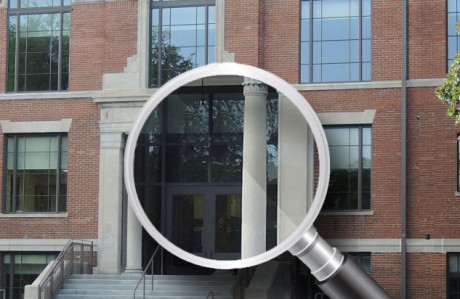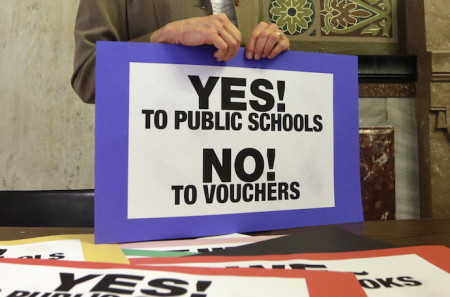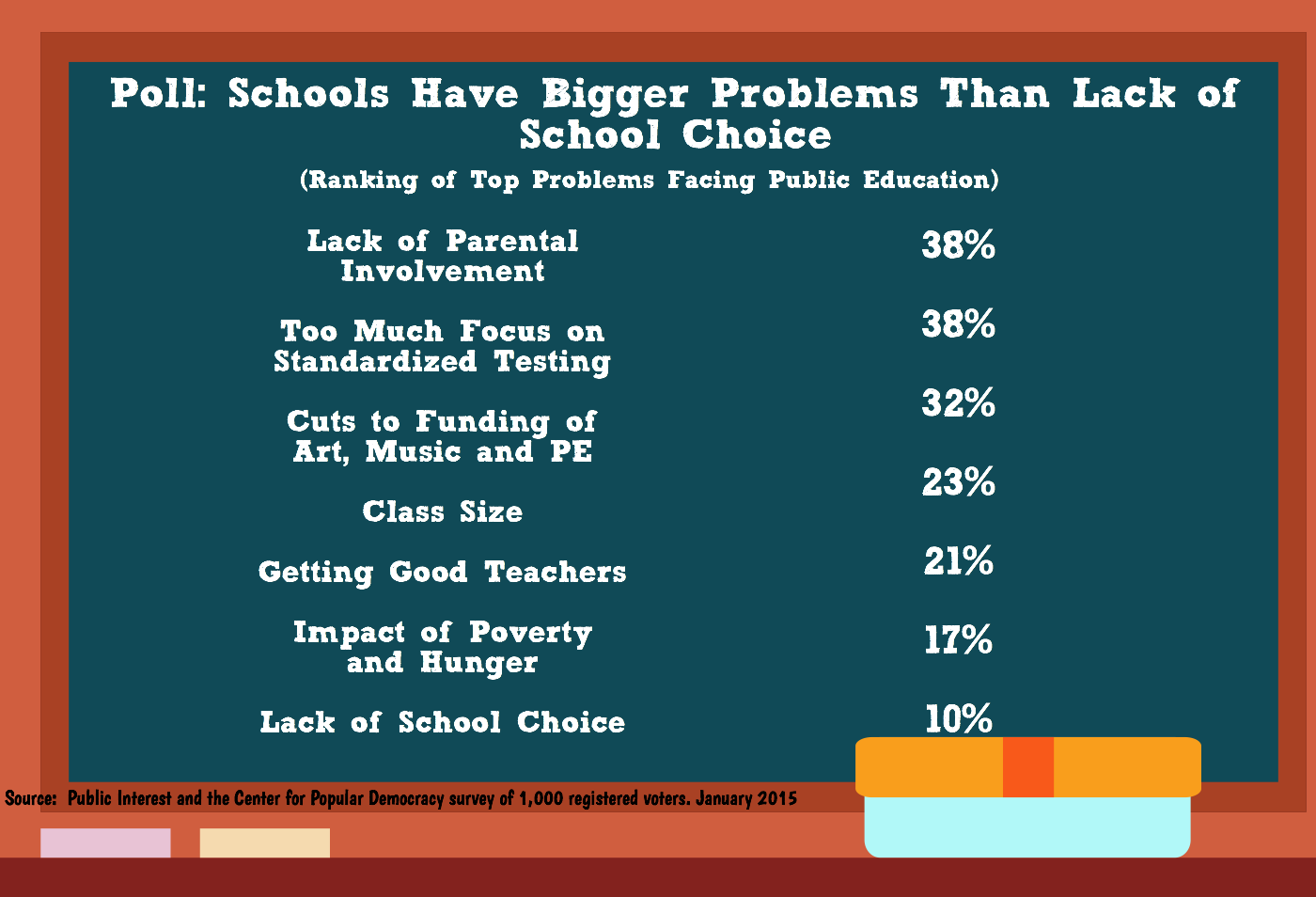 Ask an education "reform" proponent about any issue facing public education and the answer is always the same: “school choice.” Whether they're championing charter schools, vouchers or Education Savings Accounts (ESAs), advocates prefer to frame the debate around the right of parents to send their child to a better-performing school. This is merely a smokescreen to divert attention away from what school choice is really about: the transfer of public money to the private sector without accountability or transparency.
Ask an education "reform" proponent about any issue facing public education and the answer is always the same: “school choice.” Whether they're championing charter schools, vouchers or Education Savings Accounts (ESAs), advocates prefer to frame the debate around the right of parents to send their child to a better-performing school. This is merely a smokescreen to divert attention away from what school choice is really about: the transfer of public money to the private sector without accountability or transparency.
Many school choice campaigns are bankrolled by a faction of incredibly wealthy conservative donors and political groups, including the Koch Brothers and the American Legislative Exchange Council (better known as ALEC). Their agenda is clear: dismantle public education.
But it’s a safe bet you won't hear their names during National School Choice Week (Jan 25-30). What you will hear is a lot of people parroting messages about "freedom," "innovation," "options," even "civil rights" - buzzwords that underpin the campaigns to expand charter schools, vouchers and ESAs across the country. But the jargon masks the devastating impact these policies have had on public education, particularly on those students who are supposed to benefit the most.
Unaccountable Charter Schools: The Truth Hurts
Many people support the idea behind charter schools, but how many are aware of the mounting troubles the charter industry has experienced lately? Probably not enough. Proponents work very, very hard to maintain a facade of success and transparency in the face of evidence that many of these schools operate without any oversight, while wasting taxpayer money and fostering inequity and racial segregation.
Take the North Carolina State Board of Education, which just this month rejected the Department of Public Instruction's annual report on charter schools as “too negative.” Dominated by school privatization stalwarts, the board is determined to prevent any meaningful oversight of the state's charters and demanded revisions to the report before it could be submitted to the legislature.
 Scrutiny over mismanagement in the charter sector is intensifying, The Center for Popular Democracy estimated that charter school waste and fraud squandered $1.5 billion in taxpayer money in 2015.
Scrutiny over mismanagement in the charter sector is intensifying, The Center for Popular Democracy estimated that charter school waste and fraud squandered $1.5 billion in taxpayer money in 2015.
North Carolina educator Stuart Egan took the board to task in an open letter to Lt. Governor and board member Dan Forrest: "Overall, charter schools seem to lack diversity and operate under a different set of rules according to the report you are trying to squelch. The fact is that many of the charter schools you have enabled are perpetuating segregation and are not accomplishing what you advertised they would do," Egan wrote.
Given the magnitude of waste and fraud in the sector, it's unsurprising why many charter operators are hiding from accountability and regulation. And according to a new study, the expansion of unregulated charter schools, particularly in urban communities, is beginning to resemble the effort a decade ago to pump up bad mortgages that eventually blew up the economy.
"Supporters of charter schools are using their popularity in Black, urban communities to push for states to remove their charter cap restrictions and to allow multiple authorizers," explains Preston Green III of the University of Connecticut and co-author of "Are We Heading Toward a Charter School 'Bubble'?: Lessons from the Subprime Mortgage Crisis" told EduShyster. "At the same time, private investors are lobbying states to change their rules to encourage charter school growth. The combination of multiple authorizers and a lack of oversight is creating an abundance of poor-performing schools in low-income communities."
Vouchers: Who Is Really Benefitting?
According to the 2015 PDK/Gallup poll, a whopping 70 percent of Americans oppose school vouchers. They see it for what it is: a privatization scheme that subsidizes tuition for students in private schools. And perhaps they are aware that there is no conclusive evidence that vouchers improve student achievement. The public is also not fooled by the often-repeated falsehood that vouchers are primarily benefitting disadvantaged students.
 In Scott Walker's Wisconsin and Mike Pence's Indiana, where vouchers have expanded dramatically, promises that the programs would serve low-income students in failing schools didn't last. “That tale quickly and methodically changed,” said Teresa Meredith, president of the Indiana State Teachers Association. By 2015, only 2 percent of participants [in the voucher program] had attended an 'F' public school.
In Scott Walker's Wisconsin and Mike Pence's Indiana, where vouchers have expanded dramatically, promises that the programs would serve low-income students in failing schools didn't last. “That tale quickly and methodically changed,” said Teresa Meredith, president of the Indiana State Teachers Association. By 2015, only 2 percent of participants [in the voucher program] had attended an 'F' public school.
"The most expansive voucher program in America has become an entitlement program which, in large part, now benefits middle class families who always intended to send their children to private (mostly religious) schools and taxpayers are footing the growing bill,” Meredith said.
Education Savings Accounts (or Vouchers on Steroids)
In 2015, Nevada lawmakers were hoping to blaze a new trail for school choice with a new gambit, education savings accounts (ESA), which allow parents to claim more than $5,000 in state funds each year and use it for any qualified education expense. This includes religious-based private schools, but also a variety of other services, all with little or no oversight over student outcomes. In addition, states impose no quality controls on the textbooks, curriculum, tutoring, or supplemental materials that parents can purchase with ESA funds.
Education savings accounts exist in five states, but Nevada became the first to pass a bill that offered them to every public school student regardless of family income. Very few private schools in the state, however, have tuition low enough to be covered by the $5,100 or $5,700 provided annually by ESAs. Wealthier parents can supplement their own income to pay for the tuition, but for lower-income families private school will remain largely out-of-reach.

Earlier this month, a state judge slapped an injunction on the program. In his ruling, District Judge James Wilson said the law diverted public funds to pay for private school tuition and was therefore unconstitutional. The decision will be appealed because advocates have vested a lot in the scheme. ESAs are unquestionably the new school choice battleground and are being pushed in a growing number of states with proponents deploying the usual tropes about "freedom" and "flexibility" to mask their real impact: erosion of public school funding, fewer education resources, wider achievement gaps and increased segregation.
Real Innovation That Works
The good news is that a growing number of communities are finding solutions to struggling schools and achievement gaps that benefit all students, not just some. Educators and parents are working together to expand the community schools model, which is currently present in nearly 5,000 schools nationwide. When public schools extend services and programs beyond the school day, creating strong learning cultures and safe and supportive environments for both students and educators—in effect becoming community "hubs" - student outcomes improve. In 2015, Minnesota educators were instrumental in persuading the legislature to pass a bill creating a grant program for “Full-Service” Community Schools and other states may soon follow suit. To learn more about community schools, read "Investing in What Works" by the Southern Education Foundation and the Annenberg Institute for School Reform.

